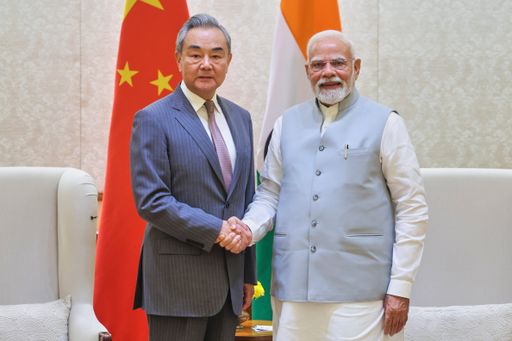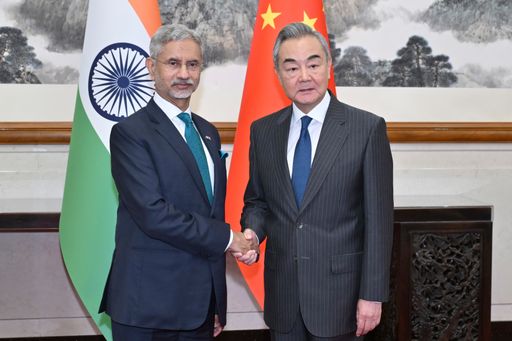Chinese Foreign Minister Wang Yi on Tuesday concluded his first visit to New Delhi in three years, marking the most notable thaw in bilateral ties since relations plunged after the deadly Galwan Valley clash along their disputed Himalayan border in June 2020.
The trip is widely viewed as a response to US President Donald Trump’s disruptive trade and foreign policies targeting New Delhi — including a punitive 50 percent tariff on Indian goods over purchases of Russian oil — and his broader geopolitical moves to contain China.
During the August 18–20 visit, the Chinese Foreign Minister met Indian Prime Minister Narendra Modi, held talks with External Affairs Minister S. Jaishankar, and co-chaired the 24th round of boundary negotiations with National Security Advisor Ajit Doval.
The two Asian neighbours also announced the resumption of direct flights that were suspended amid the Covid pandemic, the reopening of border trade, and Beijing’s decision to lift export restrictions on critical goods such as rare earths and fertilisers.
Former Indian diplomat Anil Wadhwa, who has served as Secretary (East) at the Ministry of External Affairs, stated that “all three meetings were substantive,” noting that they produced tangible outcomes across multiple fronts — from disengagement talks to cooperation on transboundary rivers and renewed supplies of critical goods.
“The statements issued after the visit are reflective of the commitment of both India and China to bring back the relationship to normalcy in every field,” Wadhwa told TRT World.
Modi hailed these outcomes, saying “stable, predictable, constructive ties between India and China will contribute significantly to regional as well as global peace and prosperity.”
Wang Yi noted that China and India, as two ancient civilisations and the world’s largest developing countries, have a shared responsibility to work together.
“This is a positive message, emphasising that the two nations can achieve much by joining forces to revitalise Asia and foster peace and prosperity,” remarked Henry Huiyao Wang, founder of the Beijing-based Center for China and Globalization (CCG).

An ‘early harvest’ solution
At the 24th round of border talks, both sides agreed to pursue an “early harvest” solution in select areas and committed to form an expert group on boundary delimitation — signalling renewed momentum toward easing tensions along the frontier.
Analysts noted the term “early harvest” refers to resolving less contentious issues first before tackling the entire dispute.
“Whether it is early harvest on disengagement, reopening border points, resumption of flights, transparency on dams, or restoring supplies of fertilisers, rare earths and tunnel boring machines — all reflect a positive and solid forward movement,” said Wadhwa.
Still, Josef Gregory Mahoney, an American professor of politics at East China Normal University, warned that while the proposal is “a bold, trust-building move,” it is far from a breakthrough. “India has merely said it is willing to form a study group, so it’s premature to declare success.”
According to China’s foreign ministry statement, the two countries will set up a working group to coordinate on border affairs, covering the eastern and middle sections, with another round on the western sector to follow. The next meeting will be held in China in 2026.
Both sides also agreed to reopen three traditional border trading markets: Renqinggang-Changgu, Pulan-Gunji, and Jiuba-Namgya.
Rare earth assurance
A key outcome was China lifting curbs on rare earth magnet exports to India. In April, responding to Trump’s trade war, Beijing had suspended exports of a broad range of critical minerals — disrupting supply chains for automakers, aerospace firms, semiconductor producers, and even military contractors.
Chinese mines account for about 70 percent of global rare earth output and nearly 90 percent of processing capacity. India has depended on China for 80–85 percent of its imports in recent years. The export ban triggered alarm in India, disrupting manufacturing and exposing vulnerabilities across transport, electronics, and basic metals.
By June, more than 35 Indian importers had not received shipments of rare earth magnets from China, putting India’s automobile sector and electric vehicle supply chains at risk.
In this backdrop, Beijing’s assurance of supplying rare earths to India during Wang Yi’s visit came as a respite and is seen by analysts as particularly significant.
“China’s decision will greatly benefit the industry, restore confidence, and remove the need to seek alternative sources, at least in the short term,” said Wadhwa.
CCG’s Wang added: “Given that rare earths are used in advanced manufacturing and defence, China reviewing this and clarifying its stance for India is a very positive sign. It shows that China attaches great importance to this neighbour.”

Trump’s tariffs as a catalyst
The timing of Wang Yi’s visit to New Delhi was no coincidence. As Washington’s punitive measures strain ties with India — while Beijing escapes comparable penalties for its dealings with Moscow — the two Asian giants have fresh incentives to move beyond hostilities.
The key question: Is this thaw tactical or a deeper shift that could reshape the global balance of power?
Trump’s tariff offensive has added urgency in New Delhi to reorient its foreign policy. US Treasury Secretary Scott Bessent accused India of “profiteering” from discounted Russian oil, while White House Trade Advisor Peter Navarro alleged India’s oil lobby was funding Russia’s war against Ukraine — even hinting the India–US partnership could unravel.
“Pressure on trade and negative statements by Trump administration officials have eroded confidence and trust,” Wadhwa explained, adding that Indian officials are perplexed by Trump’s harsh stance towards India while he courts its arch-rival Pakistan.
“The forthcoming visit of Modi to China for the Shanghai Cooperation Organization (SCO) has also necessitated easing the relationship… And China, being equally under pressure by Trump’s policies, has reached out to India and accelerated this process,” he said.
Wang concurred, contending that Washington’s unilateralism is inadvertently pushing the two Asian powers closer. “By resisting US tariffs and trade restrictions, China has stood firmly against unilateralism. India, it appears, has also come to recognise the value of getting along with its largest neighbour,” said the former Councillor of the State Council of China.
For Mahoney, the lesson for New Delhi is sobering: “India has learned that the US is an unreliable partner, that it’s foolish to serve as an outpost for American hegemony in Asia,” he said, pointing to India’s strained “strategic alliance” with Washington and its participation in the Quadrilateral Security Dialogue (QUAD), widely viewed as an US-led effort to contain China.

Towards an RIC trilateral?
Wang Yi’s visit, meanwhile, is also seen as laying the groundwork for Modi’s upcoming trip to China for the SCO summit on August 31–September 1 — his first in seven years.
Russian President Vladimir Putin will also attend, stoking speculation about a revival of the Russia-India-China (RIC) trilateral. The RIC is an informal trilateral strategic grouping that has not convened since 2021, following heightened tensions between China and India in the aftermath of the Galwan Valley clash.
“While it’s premature to suggest a trilateral agreement between China, Russia, and India will happen, it’s not unimaginable — and that alone marks a seismic shift from two years ago,” Mahoney said.
The China-India rapprochement also reflects a wider trend — the growing relevance of the Global South. Platforms like the SCO and BRICS are gaining ground as US sanctions and tariffs push emerging economies to seek alternatives, according to analysts.
For Wang, the trajectory is clear: “China and India are the biggest countries in the Global South. If they can work together, that will be a great strength for BRICS and for balancing the world. We are not seeking dominance, not seeking hegemony. It’s important to get along.”
Wadhwa was more cautious. While noting that both India and China “would like to project themselves as leaders of the Global South,” he stressed this “will not be at the cost of sacrificing their own interests vis-a-vis the US.”
In the short term, both sides will prioritise stabilising ties rather than advancing a joint multipolar agenda, he said.




















